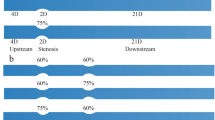Abstract
In this paper, a three-dimensional model of pulsatile blood flow througth a vessel with an asymmetric stenosis is developed to numerically study the hemodynamics circumstance under EECP (Enhanced External Counter Pulsation). The governing equations are the usual Navier-Stokes equations for unsteady elliptic flows, and are numerically solved by using finite volume method. The numerical computing is based on the animal experiment. The blood flow rate curves in a cadiac cycle pre-EECP and post-EECP are detected in a pig’s carotid respectively, the counterpulsation pressure is 0.03MPa. The blood flow rate curves are transformed to blood velocity distributions along the arterial diameter by using the Womersley arithmetic. And the Womersley velocity profiles are used as inflow boundary conditions to simulate the whole hemodynamics circumstance inside the 3-dimensional artery model. The computational results show that when EECP is applied, the blood flow rate and the wall shear stress level of the artery are increased in a cadiac cycle, as well as the pulsatile character of blood flow and wall shear stress. Which are possibly the hemodynamic actors that lead to the improving of the endothelial function which is thought to be straightly relating to the atherosclerosis.
Similar content being viewed by others
References
Texon, M. Hemodynamics basis of atherosclerosis with critique of the cholesterol—heart disease hypothesis, 2th Edition. Begell House Publishers, 1996, New York.
Charles A. Taylor, Thomas J.R. Hughes, Christopher K. Zarins. Finite element modeling of blood flow in arteries. Comput. Methods Appl. Mech. Engrg. 1998, 158: 155–196.
Du Jian-Hang, Bao Yun, Jin Ya-Fei. Study on intro-arterial hemodynamics environment under EECP with different couterpulsation pressure. Chinese Journal of Biomedical Engineering. 2005, 24(5): 620–624
Liu Qiong, Zheng Zhen-Sheng, Zhan Cheng-Yang. The relationship between hemodynamics and c-sis mRNA of EC. [J] Med Biol Eng Comput. 1997, 35(1): S147–7
Jin Ya-Fei, Zheng Zhen-Sheng, et al. The influence of EECP chronic experiment to the generation of atherosclerosis plaque in high-fat raised pigs. J Interventional Radiology. 2003, Vol 12, Sub, pp: 139–139.
K. C. Ang and J. N. Mazumdar. Mathematical Modelling of Three-Dimensional Flow through an Asymmetric Arterial Stenosis. Mathl. Comput. Modelling. 1997, 25(1): 19–29.
Perktold K, Hofer M, et al. Validated computation of physiologic flow in a realistic coronary artery branch. Journal of Biomechanics. 31(1998) 217–228.
Caro, C. G., Fitz-Gerald, J.M. and Schroter, R. C. Aheroma and arterial wall shear: observation, correlation and proposal of a shear dependent mass transfer mechanism of atherogenesis. Proc. Roy. Soc. Lond. 1971, 177, 109–159.
Caro, C. G. and Parker, K. H. The effect of hemodynamics factors on the arterial wall. Atherosclerosis-Biology and clinical Science (Edited by Olsson, A. G.). 1987, PP: 183–195. Churchill Livingstone, Edinburgh.
Perktold, K and Rappisch, G. Computer simulation of local blood flow and vessel mechanics in a compliant carotid artery bifurcation model. J. Biomechanics. 1995, 28(7): 845–856.
Du Jian-Hang, Yu Zhi, Bao Yun, Jin Ya-Fei. Numerical simulation of pulastile flow through a partial arterial stenosis. Journal of Hydrodynamics. 2006, 21(1): 1–7
Author information
Authors and Affiliations
Corresponding author
Rights and permissions
About this article
Cite this article
Du, Jh., Wu, Cl., Zheng, Zs. et al. Numerical simulation of pulsatile blood flow through asymmetric arterial stenoses under EECP. J Hydrodyn 18 (Suppl 1), 246–251 (2006). https://doi.org/10.1007/BF03400454
Published:
Issue Date:
DOI: https://doi.org/10.1007/BF03400454




